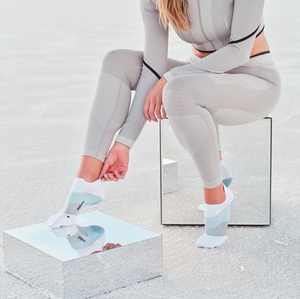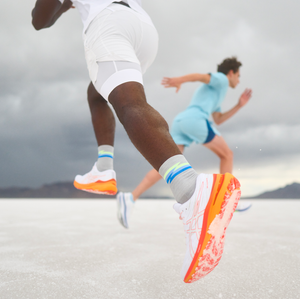Half marathons are the gateway drug of endurance events.
It goes something like this: You decide on a dare to run around the block hungover in gardening shoes: feel OK. You sign up for first 5k and buy proper shoes, socks, shorts and some kind of wicking fabric top: feel good. You have a couple glasses of wine and challenge your significant other to join you in a half-marathon: feel invincible.
Then print out a 12-week training plan. Stick to weeks one through three with the urgency of the first couple dates. Waffle a little week four, only to just get the long run in weeks five through eight. Take weeks nine and ten off in the name of tapering. “Cram” week eleven and come up lame with shin splints/an achilles injury/back spasms or any other kind of muscle pull/stomach issues on race day.
Gut it out anyway. Break into tempo to make it look good for the on-course photographers and walk it into the corral for your finishers’ medal. Locate food, beer and/or massage tent and promise yourself you’ll never get sucked in to such a thing again.
...I’m not going to make fun of that plan, I’ve lived that plan. But I will say, there is a better way. And it revolves around three things: preparation, food and sleep and fun.
The Three Keys to Running a Successful First Half-Marathon
Preparation
The temptation to jump from middle-distance fun runs to the 13.1-mile main event is inevitable. If Monica from HR can put the Ben & Jerry’s and Pinot down for a month and do a half-marathon off the couch, damn it, so can I you say. Beyond setting up a training plan that’s doable within the construct of your actual schedule, the key to a successful first half marathon is the non-training base you’ve built.
Running follows the laws of physics. The more you do the more you will do and the slower you build the more sustainable over time your routine will become. It’s nice to think there’s a pill from TV that can melt pounds or that six minutes of exercise a day will leave you looking like a back-up dancer in a boy band, but the reality is longevity...takes a long time. Build slowly and build comfortably.
My older sister, an attorney and mother of two, spent almost a decade in some form of sedentary state moving from drivers’ seat, to desk chair, to kitchen table to couch with some mild bouts of chasing toddlers/kids/preteens along the way. As her children grew older and gained independence her schedule was suddenly left open in the early mornings and late-afternoons. What to do? I suggested running and she obliged, mostly because it was the only time during the day she could completely zone out and listen to her music. When she got bitten by the bug a few weeks in, she immediately started looking online for long races, but it wasn’t until almost a year later that we ran a half marathon together.
Why? Because she wasn’t ready.
I wasn’t the only one telling her to slip into a routine before taking the steps necessary for a half-marathon. Her husband, Dr. Mark Ewens, is a family practice physician and a competitive age-group runner. His advice to her was similar to what he tells all his patients who are getting back into a new exercise routine after time away. “I tell them there’s no sense in doing something for a week and getting hurt,” he says. “Start slow and you can hold off those injuries...for at least six months.”
Joking aside, the doctor’s point is it’s about turning the heat up gradually, listening to your body and scheduling your workouts around getting the kinks out. It’s not about training up for a one-off race and then quitting. “As people age, it’s not easy to fire up a training plan and stick to it,” he says. “Dumping yourself into a schedule you’re not ready for is the best way to burn out or take yourself out.”
Food and sleep
As a father of a six-month-old toeing the start line for my most recent half last November, I had sorely fallen short on the sleep and nutrition aspect of my training. Even though I’d somehow gotten my miles in, shortfalls on the essentials of rest and fuel manifested around mile six.
It was the first half marathon in a decade where I finished with splits that weren’t negative. In fact, I was passed by a training partner around the 10k mark where he informed me I was losing about 20 seconds/mile.
I had my customary pre-race peanut butter bagel and banana, but that was about the only normal eating I did in the race lead up. Grabbing a quick midday burrito between work meetings and then grazing on Kettle Chips, maybe squeezing in a sensible salad and pasta dinner (or maybe not) didn’t do the trick for an effective performance. My blood sugar was low after mile three and I bonked by mile 10.
On the sleep front, averaging 3-4 hours a night of total shut eye combined with little REM left me bereft if not perma-groggy which made my training runs all the more ineffective. I was training to check the box, not because my body, much less heart, was into it.
What did this mess lead to besides a disappointing performance when it counted? For starters, I was about 15 pounds heavy at the start. Since I did squeeze in the workouts I reasoned, my race day muscle memory would come back. It didn’t, and I posted my slowest half by 12 minutes. My post-race recovery week stretched out to about a month. And, sadly, besides the joy from cheering on my family at the finish, my post-race glow quickly faded.
And it all could have been prevented.
Most training programs are written for people who miraculously have no jobs, kids, commitments, or life outside running. For the rest of us, it becomes more about using the time you have the best you can. My long runs could have been better spent preparing meals or *gasp* napping. In this instance, had I been honest with myself, I would have opted for re-building with effective 5k. I would have gotten better results as well as remembered why I was doing it in the first place.
In other words..
Don’t let training take over the fun
It’s always so easy when training for a longer distance to set the goal and solely focus on that—instead of why you set the goal in the first place. Remember the feeling of that first run around the block? The wind, the ruddy cheeks, the freedom. That’s what it’s about. The meals the prep and the personal bests, that’s all a byproduct of finding joy in the run itself.
Even the romanticized version of why we train often turns into a daily dirge, and that’s why it’s OK to reward yourself for milestones along the way. New shoes and socks. Fresh shorts. A couple shirts to replace those old training shirts no longer fit to dry your car with—maybe a new GPS watch you won’t be able to figure out—there’s no better time to update your swagger than just after receiving your race email confirmation.
If you can’t afford a whole new wardrobe, play it like Rocky and give the most attention to what goes on below the knees because you don’t have to look pretty if you’ve got the footwork dialed.
When I’m between paychecks and can’’t get new shoes, I at least spring for new insoles and socks. I always marvel at the positive effects of a pair of fresh Feetures! Elite Merino+ Ultra Lights that first run out of the wrapper.
And because I’m now the sedentary one, juggling kids and a career—I also rotate my pair of Feetures! Graduated Compression Light Cushion knee-high compression sleeves during the workweek for those long periods of time staring at rectangles during the day. And don’t even think about getting in a car or on a plane on the evening of a destination race without something to keep the blood flowing through those fickle calf muscles.
After all, rested, fed, trained and happy legs...are the fastest legs. And fast legs will ensure your first half will definitely not be your last.



Leave a comment